2013 Can Am Maverick 1000 Top Speed
Winner 2013 Sport UTV Shootout
Its look is menacing. Its power is strong. BRP's Can-Am Maverick 1000R X rs is an extreme Side-by-Side that, from our experience, takes fast trail riding, dune whacking and rock crawling to the next level.
For a stock UTV, the Maverick X rs is about the business of getting work done – in a dirty, recreational way.
ATV.com took delivery of our Can-Am Maverick X rs in early June and we, along with our Polaris RZR XP 900 LE with electronic power steering (EPS), began a journey of evaluating, testing and learning. This feature focuses on the Maverick and our impressions.
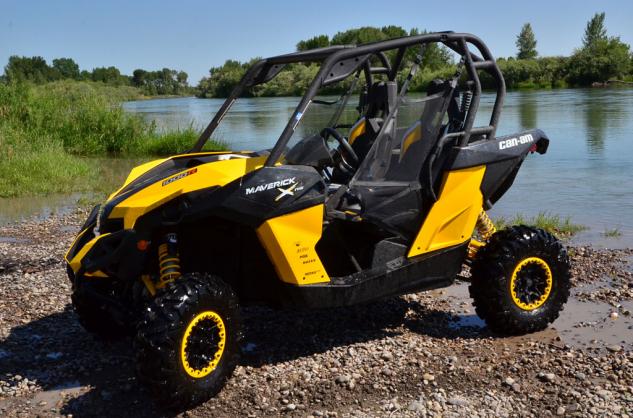
The Maverick X rs is a Side-by-Side that is built around a robust attitude. When we first received it, we spent a good 30 minutes looking over its front and rear suspension, frame, beadlock rims, tires, cockpit, seats, floorboards, and driver and passenger protection. It is not a Side-by-Side that is cheaply built. Furthermore, we found the Maverick's fit-and-finish to be excellent – a new purchaser would be proud to show off this sport UTV to his or her dirt playing pals.
Inside Info
This particular Maverick X rs is powered by a 976cc, V-Twin, liquid-cooled, SOHC, 8-valve (4-valve/cyl) motor that has a bore and stroke of 91mm by 75mm, respectively. Can-Am reports the big 976 wonks out 101 sea level horsepower at the crank. Can-Am labels this Rotax-built and supplied motor as the "1000R V-Twin."
 The Maverick X rs has a fierce look. Its hood adds to its muscular attitude. But, from the driver's seat, the two bulges on the hood limit a driver's line-of-site when driving up and over a sharp hill.
The Maverick X rs has a fierce look. Its hood adds to its muscular attitude. But, from the driver's seat, the two bulges on the hood limit a driver's line-of-site when driving up and over a sharp hill.
Atomizing the fuel and oxygen mixture is a large mouth 54mm Bosch throttle body that diverges the mixture to two Siemens VDO injectors.
COMPARISON: Read our review of the Can-Am Maverick MAX X rs
Throttle input is handled via BRP's iTC – Intelligent Throttle Control – which is throttle-by-wire. We will bring the iTC to the forefront shortly.
Dumping the spent fuel is a tuned manifold that routes the exhaust through dual pipes, producing an erotic note at idle and throughout its RPM range.
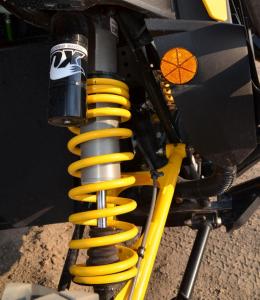 Up front, the A-arm front suspension and Fox Podium shocks provided ample bump soak to keep the Maverick nimble and in control for fast drifts around a sharp bend.
Up front, the A-arm front suspension and Fox Podium shocks provided ample bump soak to keep the Maverick nimble and in control for fast drifts around a sharp bend.
The 2WD/4WD drive system receives its go-forward commands from a continuous variable transmission (CVT) with a Zylon reinforced drive belt. The Zylon belt is stronger, so says BRP, than a regular drive clutch belt, due to its ability to handle heat from the high-demand squeeze loads the primary and secondary clutches inflict on a drive belt. The transmission is an on-demand system that gives the driver the ability to shift from 2WD to 4WD at the toggle switch level.
Front suspension is a double A-arm unit that delivers 14 inches of travel. Keeping the tail tidy and tight is BRP's Torsional Trailing Arm (TTA) independent rear suspension. This rear unit, according to Can-Am, is a compact and lightweight five-link system which eliminates bump and steer and scrub to optimize tire-to-dirt contact. The rear suspension, like the front, laps up the whoopies with 14 inches of travel.
With all the aforementioned, the Maverick X rs has 13 inches of ground clearance. Fox Podium X Performance piggyback shocks with compression and preload adjustments keep the four Maxxis Bighorn tires tied to the dirt. The tires roll on true 12-inch beadlock aluminum wheels.
The Maverick X rs is a brute. Knowing this, Can-Am offers two ignition keys. A black performance key unleashes the motor's potential; a gray learner's key governs the Maverick's 1000R motor to run between 60 to 70 percent of its potential – limiting RPM and MPH. This is all part of iTC. Trust us; this is a smart idea from Can-Am as the Maverick X rs can be King Kong livid when a driver unleashes motor madness.
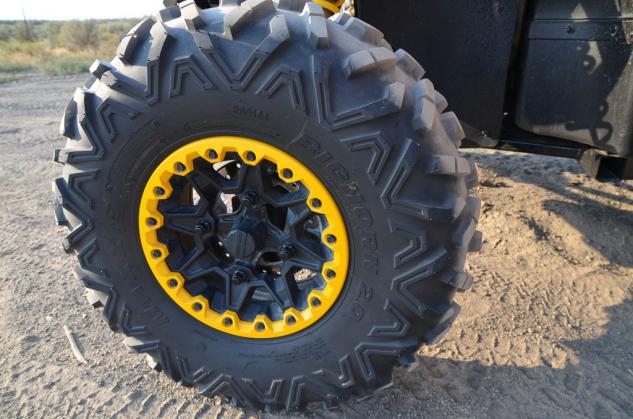 The Maxxix Bighorn tires mated to true beadlock rims give the Can-Am Maverick 1000R X rs an advantage over its competitors; operators can drop tire pressure, lockdown the tire's bead and tear 'em up on the dunes.
The Maxxix Bighorn tires mated to true beadlock rims give the Can-Am Maverick 1000R X rs an advantage over its competitors; operators can drop tire pressure, lockdown the tire's bead and tear 'em up on the dunes.
Not to end there, mounted on the dashboard is a toggle switch that further limits or amps out the motor's fierceness. The gray toggle switch has Sport and Progressive (standard) modes that work in tandem with the black and gray keys. Sport mode offers a linear throttle control.
COMPARISON: Read our review of the Polaris RZR XP 900 EPS LE
So, two keys each with additional performance modes for a total of four operating modes: fast and really fast, tamed and really tamed. For us, this makes the Maverick X rs consumer friendly; friendly for the novice/beginner, and friendly for the driver who needs (and wants) hefty torque and horsepower.
Interior
The cockpit is roomy. We appreciate the three inches of adjustability the driver's seat provides. Moving the seat forward or back gives a driver room to stretch out to the steering wheel and throttle. The recaro-style seats provide ample stability from its combo seatbelt/shoulder harness system. Both the driver and passenger seats have side support wings that wrap each occupant. Though not a full-on race seat, we found it to be wholly adequate for our driving and riding needs.
The tilt wheel has sufficient lateral range to match a driver's arm length and torso height.
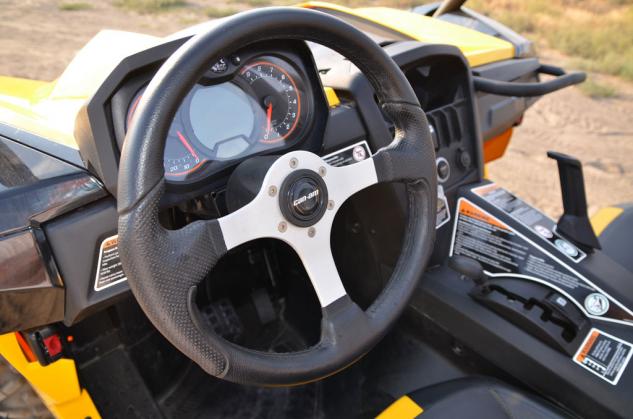 The sports car steering wheel is comfortable. Also, the instrument pod is well laid out and delivers good information. The steering wheel and instrument pod tilt together.
The sports car steering wheel is comfortable. Also, the instrument pod is well laid out and delivers good information. The steering wheel and instrument pod tilt together.
The Maverick X rs has modern Euro- and U.S.-sports car allure. This is evident with its push button start and information rich instrument pod. Roll the key right, press the brake pedal and press the Start button and the big four-stroke breathes in its fuel and oxygen and kicks out a sweet rumble. The instrument gauge reports engine vitals, ground speed and engine speed.
The Ride
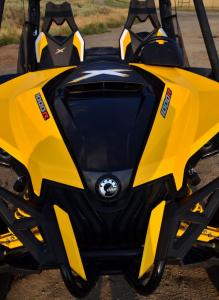
Kicking the Maverick into gear is a matter of positioning the shift lever into its appropriate gate (notch). This took a moment to get used to, especially after climbing out of the cab of our Polaris 900 RZR XP LE where its shift selector slides forward and back without lockdown notches. The Maverick's gates are not a bad thing, just different. The notches prevent the shift lever from being hit and placed into a different gear without conscious effort; it's a safety measure and we like it.
The big bulbous hood on the Maverick is tough looking. But, when driving the Maverick up and over a sharp hill, the right side hood bulge obstructed our line-of-sight as we sought to see the dips, rocks and valleys that lied ahead. The limited view made descents spooky when traversing down unfamiliar territory; we prefer a flatter hood that gives a clear line-of-site.
The 2013 Maverick X rs lacks power steering. For the most part, this was not a hindrance, except when spinning the wheel to turn out the Maxxis Bighorns from a rut or from between two rocks. In slow maneuvers in sand, the Maverick required more than average input to rotate the steering wheel. On one occasion, we dropped the Maverick into a long gutted out rut and as we began to rotate the wheel counter-clockwise to lumber out from the rut, the steering wheel spun left, unleashing itself from our hands. We believe the power steering system used on Can-Am's Commander should migrate to the Maverick X rs. The 2014 Commander has a three-speed system that gives the driver options to dial in fast, medium or slow steering modes which match vehicle speed and driver need for a given terrain.
COMPARISON: Read our preview of the Polaris RZR XP 1000
At moderate to fast speeds, the manual steering system has proper pressure, call it feedback, to keep the sport Side-by-Side gathered in; it felt light and manageable with no moments to over-correct.
 With its wide A-arms and Fox Podium shocks mated to progressive coil-over springs, the Maverick X rs has the ability to collapse its front end thus keeping the nose flat. (Photo by Jake Allred)
With its wide A-arms and Fox Podium shocks mated to progressive coil-over springs, the Maverick X rs has the ability to collapse its front end thus keeping the nose flat. (Photo by Jake Allred)
The iTC throttle worked as Can-Am reported. When taking on kidney busting sand moguls, we would float up and down in the driver's seat and bump the throttle as the unit rocked back and forth in a somewhat violent fashion. The iTC drive-by-wire reduced throttle pulses by keeping the throttle's signal to the motor flat and, when needed, progressive. For us, iTC is a keeper as it kept the Maverick X rs from turning into a runaway bucking bronco.
The protective nets for the driver and passenger proved adequate. For the passenger, a center-mounted grab stick, near the shift selector, and a crossbar on the dashboard gave our passengers preventative measures to keep their sandwich from making a hasty exit from whence it came.
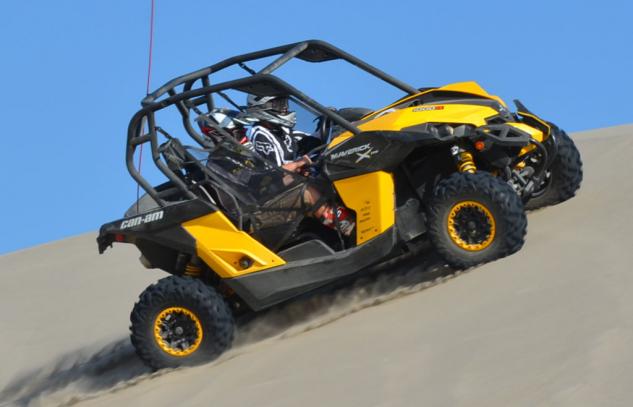 With its wide stance, the Maverick 1000R X rs would hold a line tight across a sandy slope. Passengers appreciated how the Maverick did not flip sand up into the cockpit.
With its wide stance, the Maverick 1000R X rs would hold a line tight across a sandy slope. Passengers appreciated how the Maverick did not flip sand up into the cockpit.
One notable critical point; the passenger cockpit area receives much heat from the big Twin motor. Passengers often complained about the heat, especially if the day itself was hot. Furthermore, heat boiled up from the shift selector, blowing on the driver's right arm. Now on cold days this would be fine, but Can-Am needs to add more heat shielding for the passenger. After about 40 minutes, passengers wanted to walk home.
The Maxxis Bighorn tires withstood sharp punishing blows from our many desert lava rocks; we never busted a lug while rock hopping. We appreciate the beadlock rims, especially when we dropped the air pressure in the meaty tires. The Maverick's tires did not spin when loaded down in loose sand, which challenged the Maxxis' rim-to-bead lock.
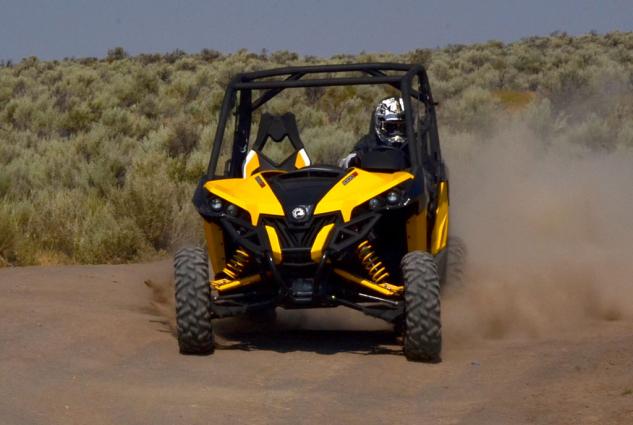 In in high-speed drifts, the Can-Am Maverick X rs is nailed down. It seemed the harder it was pushed, the more secure it became.
In in high-speed drifts, the Can-Am Maverick X rs is nailed down. It seemed the harder it was pushed, the more secure it became.
At mid-point during our evaluation period, oil stains began appearing in our enclosed trailer. After monitoring the Maverick's oil level, we noticed the motor was slowly showing reduced levels on the dipstick. We inspected the Maverick's underside and discovered oil buildup near the PTO side. We contacted BRP and asked permission to repair the oil leak.
Rexburg Motor Sports pulled off the motor's crankcase and found the crankcase gasket at the PTO end did not fully seat/seal. The servicing dealer, as well Can-Am, told us this was a rarity.
COMPARISON: Read our review of the Arctic Cat Wildcat 1000i
Also, on a warm Friday at the St. Anthony Sand Dunes, we parked our Maverick X rs nose down on a slight decline (about a three-degree slope). When we started unit, the clutches would not engage. Being a short distance from the trailer, we pulled the Maverick to its lair and deposited it at the servicing dealer. Here we learned the driven clutch's mounting bolt unseated itself, which cleared the path for the driven clutch to spin off its driveshaft. We understand from the servicing dealer, a Can-Am bulletin refers a dealer, when servicing the driven clutch, to use an updated stud to secure the driven clutch to its shaft.
 Going for a bath is as fun as getting dirty. The Can-Am Maverick is a muddy buddy as well as a dirty buddy.
Going for a bath is as fun as getting dirty. The Can-Am Maverick is a muddy buddy as well as a dirty buddy.
Bottom Line
The Can-Am Maverick 1000R X rs is the real deal. It is not perfect, but we've never found a perfect product in our life. In spite of the oil leak and dismounted driven clutch, we never lost confidence in the Maverick X rs. Why is that? It is a strong and stable Side-by-Side. It holds corners and stays flat in the chicanes and S-turns. Its technology is superb; and for the money, a consumer receives far more driver, performance and technology amenities than its competitors. We believe for model year 2014, the Maverick X rs will continue to gain a larger fan base.
2013 Can Am Maverick 1000 Top Speed
Source: https://www.atv.com/manufacturers/can-am/2013-camam-maverick-x-rs-1000r-longterm-evaluation-2208.html

0 Komentar